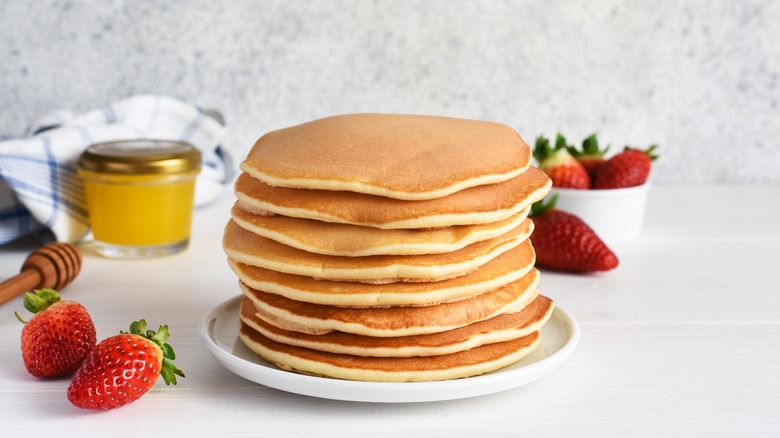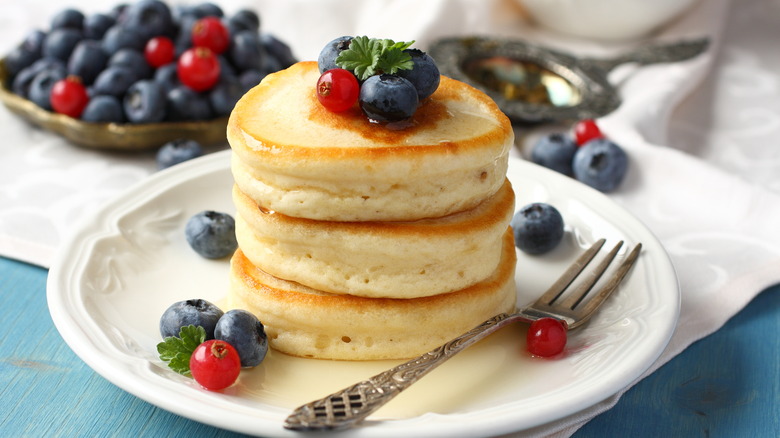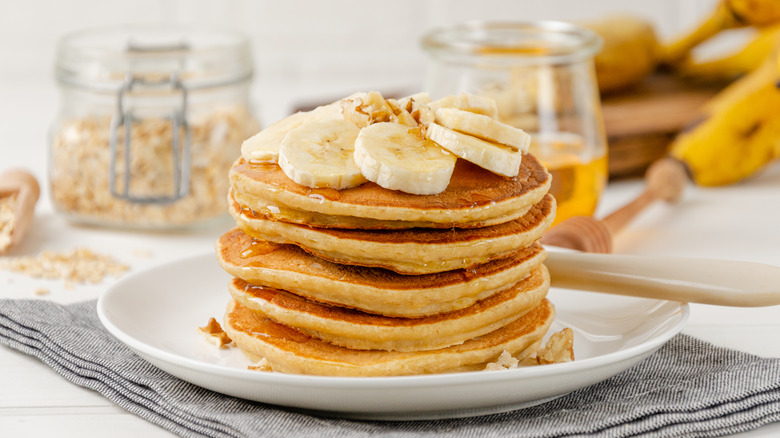How Scotch Pancakes Differ From American Stacks
Humans likely have been enjoying pancakes for as long as they have harnessed the power of fire. However, those early pancakes made of ground einkorn wheat eaten by people living during the Stone Age were hardly the fluffy, golden creations we enjoy today. Today, pancakes in their different forms are enjoyed around the world, from the flour-based disks served with maple syrup in the United States to berries on top of Japanese soufflé pancakes that use baking powder and cream of tartar to achieve some of the lightest, highest-rising pancakes found around the world. Conversely, the French have found delight in flat, thin crepes that can be sweet or savory. While not often associated with Scandinavia, Finland also has its own version of the pancake, which is made from a custardy batter that is baked in the oven and served with powdered sugar, cream, fruits, or jam.
No matter the country of origin, pancakes are frequently adapted to a person's tastes, especially the toppings. The American version of pancakes has become a playground for creative cooks who want to turn this breakfast staple into a marvel of stacked deliciousness with toppings ranging from chocolate syrup to bacon. Not to be outdone, the United Kingdom has its own version of the flat cake, called Scotch pancakes. While similar to the American pancake, the two have some subtle differences.
Scotch pancakes served simply
Also called Drop Scones, Scotch pancakes are enjoyed for breakfast and as a snack in the United Kingdom. The main difference between Scotch and American pancakes is that the Scotch version is simpler. Ingredients include self-rising flour, salt, caster sugar, and eggs. Caster sugar provides a more caramelized taste. In contrast, the recipe for Scotch pancakes from BBC Good Food calls for plain flour, as well as ground cinnamon, baking powder, and milk. Yet another slightly different version comes from Chef Nigella Lawson, who recalls eating them as an after-school snack growing up, who uses white wine vinegar and baking soda to give her Scotch pancakes a lightness and fluffiness.
One of the key differences between the two versions of pancakes is how they are eaten. Lawson says they are enjoyed more like toast with butter and jam versus butter and maple syrup like American pancakes. However, others use butter or fruit and yogurt or some jam. Like American pancakes, Scotch pancakes are often eaten stacked on one another.
Pancakes: a breakfast staple
While American pancakes may often be made from a boxed mix, making them from scratch is a relatively easy process. A recipe for easy pancakes includes flour, baking powder, sea salt, milk, egg, and oil. Most frequently topped with butter and maple syrup, it's not uncommon to see pancakes with a variety of sweet and savory toppings. What is uncommon is to see American pancakes served at meals other than breakfast, brunch, or breakfast-for-dinner nights.
Pancakes have a long history in the United States. Betty Crocker has been publishing the same recipe for pancakes in its cookbooks since 1950. However, there is one particular American pancake recipe with a different ingredient from its more mainstream counterparts: Cornmeal. This recipe may closely resemble the pancakes that the early American Colonialists ate, made of cornmeal or buckwheat and called johnnycakes. Even President Thomas Jefferson was a fan, but the version he ate would have been heftier and fluffier thanks to a leavening agent and called griddlecakes. To this day, pancakes go by many names, such as flapjacks or slapjacks.
Both Scotch pancakes and American flapjacks are cooked the same way with some hot oil or melted butter on a griddle or pan. The pancakes, whether in the United Kingdom or the United States, should be flipped and cooked on both sides until golden brown. All that is left to do is enjoy them with your favorite toppings, whether simple, sweet, or savory.


